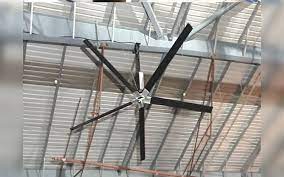Efficient air circulation is vital in large spaces such as warehouses, manufacturing facilities, and other expansive environments. Two primary types of fans used for this purpose are High-Volume, Low-Speed (HVLS) fans and traditional warehouse fans. While each type of fan has its distinct advantages, understanding their benefits can help in making informed decisions for maintaining optimal conditions in large spaces. This article explores the benefits of both HVLS fans and warehouse fans, highlighting their features, applications, and contributions to improved air quality and operational efficiency.
Understanding HVLS Fans
High-Volume, Low-Speed (HVLS) fans are large-diameter fans that move a significant volume of air at low rotational speeds. These fans, typically measuring between 7 and 24 feet in diameter, are designed to create a gentle, consistent airflow across a large area. They are widely used in commercial, industrial, and agricultural settings to improve air circulation, maintain temperature consistency, and enhance comfort.
Benefits of HVLS Fans
1. **Efficient Air Movement and Coverage**
– **Wide Area Coverage:** HVLS fans are capable of moving air over a vast area, which means fewer fans are required to cover large spaces. A single HVLS fan can replace several smaller fans, simplifying installation and maintenance.
– **Consistent Airflow:** These fans generate a large column of air that moves downwards and spreads out across the floor, creating an even airflow that helps eliminate hot and cold spots. This consistent movement ensures that air is mixed uniformly, improving overall air quality and temperature regulation.
2. **Energy Efficiency and Cost Savings**
– **Lower Energy Consumption:** HVLS fans operate at low speeds, which significantly reduces energy usage compared to traditional high-speed fans. They provide efficient air movement with minimal power consumption, leading to reduced utility bills and operational costs.
– **Supplemental HVAC Support:** In summer, HVLS fans create a cooling effect by enhancing air circulation, which can reduce the need for air conditioning. In winter, they help distribute warm air more evenly, reducing the reliance on heating systems and lowering energy costs.
3. **Enhanced Comfort and Productivity**
– **Improved Worker Comfort:** By maintaining a consistent temperature and reducing humidity levels, HVLS fans create a more comfortable environment for workers. This can lead to increased productivity and reduced absenteeism, as employees are less likely to suffer from heat-related fatigue or discomfort.
– **Better Air Quality:** The continuous airflow provided by HVLS fans helps to reduce the accumulation of dust, fumes, and other airborne contaminants, leading to improved air quality and a healthier workspace.
4. **Long-Term Durability and Low Maintenance**
– **Robust Design:** HVLS fans are built for durability, with high-quality materials and components that ensure a long operational lifespan. Their low-speed operation reduces wear and tear, resulting in fewer maintenance requirements and lower long-term costs.
– **Reduced Maintenance Needs:** Due to their large coverage area and efficiency, fewer HVLS fans are needed, which simplifies maintenance tasks and reduces the need for frequent repairs or replacements.
5. **Environmental and Sustainability Benefits**
– **Reduced Carbon Footprint:** The energy efficiency of HVLS fans contributes to a lower carbon footprint for facilities, supporting sustainability goals and reducing environmental impact.
– **Support for Green Building Certifications:** The use of HVLS fans can contribute to earning points in green building certification programs like LEED, enhancing the overall sustainability profile of a facility.
Understanding Warehouse Fans
Traditional warehouse fans include a variety of smaller, high-speed fans such as pedestal fans, wall-mounted fans, and floor fans. These fans are commonly used to provide localized cooling and improve air circulation in specific areas within a warehouse or large facility.
Benefits of Warehouse Fans
1. **Targeted Cooling and Airflow**
– **Localized Air Movement:** Warehouse fans are effective at providing targeted cooling and air movement in specific areas. They can be strategically placed to direct airflow where it is needed most, such as workstations, loading docks, or areas with high heat production.
– **Flexibility in Placement:** Smaller warehouse fans can be easily moved and repositioned to adapt to changing needs within a facility. This flexibility allows for quick adjustments to airflow patterns and cooling requirements.
2. **Cost-Effective Solutions**
– **Lower Initial Investment:** Warehouse fans generally have a lower upfront cost compared to HVLS fans, making them a more affordable option for facilities with limited budgets. They provide a cost-effective solution for improving air circulation and cooling in smaller or confined spaces.
– **Simple Installation:** Most warehouse fans require minimal installation effort and can be set up quickly. This makes them a convenient option for immediate cooling needs or temporary use.
3. **Versatility and Portability**
– **Adaptable to Various Spaces:** Warehouse fans can be used in a variety of settings, from small storage areas to larger production zones. Their adaptability makes them suitable for diverse applications within a facility.
– **Portable Options:** Many warehouse fans are designed to be portable, allowing them to be easily moved to different locations as needed. This portability is beneficial for addressing specific cooling or ventilation needs on a temporary or as-needed basis.
4. **Quick Response to Heat Issues**
– **Immediate Cooling Relief:** Warehouse fans can be quickly deployed to provide immediate cooling relief in areas experiencing high temperatures. This rapid response is particularly useful in situations where sudden heat spikes occur or where temporary cooling is required.
– **Effective for Spot Cooling:** Smaller fans are ideal for spot cooling, providing focused airflow to specific areas or equipment that generate excessive heat. This helps prevent overheating and ensures that critical machinery operates efficiently.
5. **Diverse Fan Types and Features**
– **Variety of Fan Types:** Warehouse fans come in various types, including pedestal fans, wall-mounted fans, and oscillating fans. Each type offers unique benefits and can be selected based on specific cooling or ventilation needs.
– **Customizable Settings:** Many warehouse fans feature adjustable speeds, oscillation, and directional control, allowing for customizable airflow solutions. This versatility enables users to tailor the cooling effect to their preferences and requirements.
Comparative Analysis
While both HVLS and warehouse fans offer significant benefits, the choice between them depends on the specific needs and conditions of the facility:
– **Coverage and Airflow:** HVLS fans are ideal for large, open spaces where uniform air distribution is required. Their ability to cover vast areas with a single fan makes them a cost-effective and energy-efficient solution for maintaining consistent airflow. In contrast, warehouse fans are better suited for targeted cooling in smaller or localized areas, providing flexibility and immediate relief where needed.
– **Energy Efficiency:** HVLS fans excel in energy efficiency, particularly in large facilities where extensive air movement is required. Their low-speed operation reduces energy consumption, leading to substantial cost savings over time. Warehouse fans, while typically less energy-efficient, offer a lower initial investment and can be an economical choice for smaller applications or temporary use.
– **Comfort and Productivity:** Both types of fans contribute to improved comfort and productivity, but in different ways. HVLS fans provide a more uniform and consistent airflow, which is beneficial for maintaining overall comfort in large spaces. Warehouse fans, on the other hand, offer quick and focused cooling, which can enhance comfort and productivity in specific work areas or hotspots.
– **Maintenance and Durability:** HVLS fans are designed for long-term durability and require minimal maintenance, making them a reliable choice for continuous use in large facilities. Warehouse fans, while easier to move and install, may require more frequent maintenance and replacement due to their higher operational speeds and localized use.
Conclusion
Both HVLS fans and warehouse fans offer valuable benefits for improving air circulation and maintaining optimal conditions in large spaces. HVLS fans provide efficient, uniform air movement, energy savings, and long-term durability, making them ideal for large, open areas. Warehouse fans offer targeted cooling, flexibility, and quick deployment, making them suitable for specific areas and immediate needs. By understanding the unique advantages of each fan type, facilities can make informed decisions to enhance air quality, comfort, and operational efficiency in their environments.














